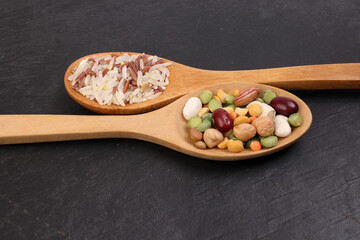Millet vs. Beans: A Nutritional Showdown
When examining the world of grains and legumes, millet and beans emerge as two incredibly nutritious options. Each has been a staple in various parts of the world for thousands of years. Below, we delve deep into their nutritional profiles, comparing and contrasting their benefits, so that readers can make informed decisions about their dietary choices.
Introduction:
Millet and beans, though from different botanical families, have both played crucial roles in human nutrition. While millet is a group of small-seeded grasses used as cereal crops, beans refer to the seeds of flowering plants in the Fabaceae family, commonly consumed as legumes.
Basic Nutritional Overview:
Millet:
Calories: Millet is relatively calorie-dense, providing energy primarily in the form of carbohydrates.
Protein: Moderate protein content, with essential amino acids.
Fats: Low in fat, but contains beneficial fatty acids.
Carbohydrates: Major source of energy in millet. Contains dietary fiber beneficial for digestive health.
Minerals: Rich in magnesium, phosphorus, iron, and zinc.
Vitamins: Contains B vitamins, especially niacin, B6, and folic acid.
Beans:
Calories: Beans provide a good balance of proteins and carbohydrates, making them moderately calorie-dense.
Protein: High in protein, a crucial source of amino acids, especially for vegetarians and vegans.
Fats: Generally low in fat, with certain types like soybeans being exceptions.
Carbohydrates: Provides complex carbohydrates and a high amount of dietary fiber.
Minerals: Excellent source of iron, calcium, magnesium, phosphorus, and potassium.
Vitamins: Rich in B vitamins, particularly folate.
Deep Dive: Nutritional Benefits
Protein Power:
Beans are superior in terms of protein content. They not only contain higher amounts but also a more complete amino acid profile, especially when combined with grains. This makes beans an essential food for those not consuming animal products. Millet, while still a good protein source, doesn’t offer as much as beans.
Carbohydrate and Fiber Content:
Both millet and beans offer complex carbohydrates, which are crucial for sustained energy. However, beans usually have a lower glycemic index, meaning they release sugar into the bloodstream more slowly. Beans are also richer in dietary fiber, which supports digestive health, aids in controlling blood sugar, and can help in weight management.
Vitamin and Mineral Magic:
Millet is a powerhouse of magnesium and phosphorus, essential for bone health and energy production. Additionally, its iron content aids in preventing anemia.
Beans shine in terms of iron, especially for plant-based diets, and their high folate content is beneficial for pregnant women. Beans also supply a good amount of calcium, especially important for those avoiding dairy.
Antioxidants and Other Compounds:
Millet contains antioxidants like quercetin, which can help combat oxidative stress. Additionally, it has been found to contain compounds that might benefit heart health.
Beans, on the other hand, boast a variety of phytochemicals, which can offer protection against chronic diseases. Their rich antioxidant content helps in reducing the risk of cardiovascular diseases and certain cancers.
Digestibility and Anti-Nutrients:
Beans often contain anti-nutrients like phytic acid, which can inhibit the absorption of certain minerals. However, methods like soaking, sprouting, and cooking can significantly reduce these. Beans can also cause digestive discomfort for some due to their high fiber and complex sugar content.
Millet also contains anti-nutrients, but in general, it's considered easier on the stomach than many other grains. Some types of millet, especially pearl millet, might have higher amounts of goitrogenic compounds which can affect thyroid function if consumed excessively.
Environmental and Economic Considerations:
Millet is drought-resistant, making it a sustainable choice in areas with water scarcity. Its cultivation supports biodiversity and soil health.
Beans, being legumes, have the unique ability to fix nitrogen, enhancing soil fertility. They require fewer pesticides and synthetic fertilizers, making them eco-friendly and sustainable.
Conclusion:
Both millet and beans have an array of nutritional benefits. While beans are a superior protein source, millet offers a well-rounded nutrient profile. Their combined consumption can ensure a balanced intake of essential nutrients. Environmentally, both crops present sustainable options. The choice between them should be based on individual nutritional needs, dietary preferences, and regional availability.
Which of the two—millet or beans—is richer in protein content?
How do the carbohydrate profiles of millet and beans differ in terms of glycemic index?
Which grain is known for its high magnesium and phosphorus content?
Why are beans particularly beneficial for pregnant women?
What environmental benefit do beans offer in terms of soil fertility?







0 Comments
please do not enter spam link in the comment box.